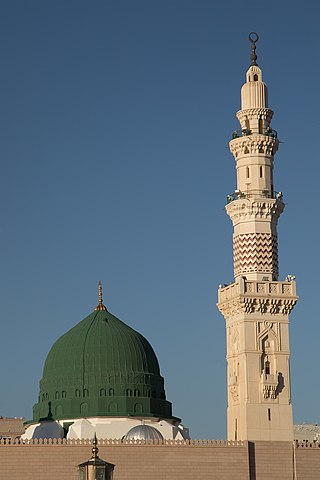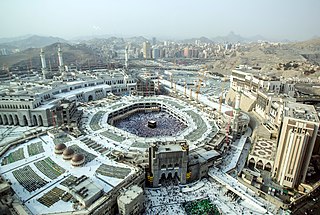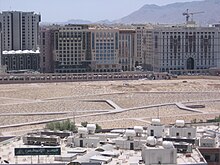
Mecca is the capital of Mecca Province in the Hejaz region of western Saudi Arabia and the holiest city in Islam. It is 70 km (43 mi) inland from Jeddah on the Red Sea, in a narrow valley 277 m (909 ft) above sea level. Its last recorded population was 2,385,509 in 2022. Its metropolitan population in 2022 is 2.4 million, making it the third-most populated city in Saudi Arabia after Riyadh and Jeddah. Around 44.5% of the population are Saudi citizens and around 55.5% are foreigners from other Muslim countries. Pilgrims more than triple the population number every year during the Ḥajj pilgrimage, observed in the twelfth Hijri month of Dhūl-Ḥijjah. With over 10.8 million international visitors in 2023, Mecca was one of the 10 most visited cities in the world.

Medina, officially Al-Madinah al-Munawwarah and also commonly simplified as Madīnah or Madinah, is the capital of Medina Province in the Hejaz region of western Saudi Arabia. It is one of the oldest and most important places in islamic history. One of the most sacred cities in Islam, the population as of 2022 is 1,411,599, making it the fourth-most populous city in the country. Around 58.5% of the population are Saudi citizens and 41.5% are foreigners. Located at the core of the Medina Province in the western reaches of the country, the city is distributed over 589 km2 (227 sq mi), of which 293 km2 (113 sq mi) constitutes the city's urban area, while the rest is occupied by the Hejaz Mountains, empty valleys, agricultural spaces and older dormant volcanoes.

The Hejaz is a region that includes the majority of the west coast of Saudi Arabia, covering the cities of Mecca, Medina, Jeddah, Tabuk, Yanbu, Taif and Baljurashi. It is thus known as the "Western Province", and it is bordered in the west by the Red Sea, in the north by Jordan, in the east by the Najd, and in the south by the Region of 'Asir. Its largest city is Jeddah, which is the second-largest city in Saudi Arabia, with Mecca and Medina, respectively, being the fourth- and fifth-largest cities in the country.

The Prophet's Mosque is the second mosque built by the Islamic prophet Muhammad in Medina, after that of Quba, as well as the second largest mosque and holiest site in Islam, after the Masjid al-Haram in Mecca, in the Saudi region of the Hejaz. The mosque is located at the heart of Medina, and is a major site of pilgrimage that falls under the purview of the Custodian of the Two Holy Mosques.

A shrine is a holy or space dedicated to a specific deity, ancestor, hero, martyr, saint, daemon, or similar figure of respect, wherein they are venerated or worshipped. Shrines often contain idols, relics, or other such objects associated with the figure being venerated. A shrine at which votive offerings are made is called an altar.

Diriyah, formerly romanized as Dereyeh and Dariyya, is a town and governorate in Saudi Arabia located on the northwestern outskirts of the Saudi capital, Riyadh. Diriyah was the original home of the Saudi royal family, and served as the capital of the Emirate of Diriyah under the first Saudi dynasty from 1727 to 1818. Today, the town is the seat of the Diriyah Governorate—which also includes the villages of Uyayna, Jubayla, and Al-Ammariyyah, among others—and is part of Ar Riyad Province.
The Wahhabi war, also known as the Ottoman-Saudi War, (1811–1818) was fought from early 1811 to 1818, between the Ottoman Empire and the Emirate of Diriyah, the First Saudi State, resulting in the destruction of the latter.

Jannat al-Baqi is the oldest and first Islamic cemetery of Medina in the Hejazi region of present-day Saudi Arabia. It is also known as Baqi al-Gharqad.

Sunni Islam is the state religion of Saudi Arabia. The kingdom is called the "home of Islam"; it was the birthplace of the Islamic prophet Muhammad, who united and ruled the Arabian Peninsula. It is the location of the cities of Mecca and Medina, where Prophet Muhammad lived and died, and are now the two holiest cities of Islam. The kingdom attracts millions of Muslim Hajj pilgrims annually, and thousands of clerics and students who come from across the Muslim world to study. The official title of the King of Saudi Arabia is "Custodian of the Two Holy Mosques"—the two being Al-Masjid al-Haram in Mecca and Al-Masjid al-Nabawi in Medina—which are considered the holiest in Islam.

Mount Uhud is a mountain north of Medina, in the Hejazi region of Saudi Arabia. It is 1,077 m (3,533 ft) high and 7.5 km (4.7 mi) long. It was the site of the second battle between the Islamic prophet Muhammad and the polytheists of his tribe of Quraysh. The Battle of Uhud was fought on 19 March, 625 CE, between a force from the small Muslim community of Medina and a force from Mecca, in north-western Arabia.

The holiest sites in Islam are predominantly located in the Arabian Peninsula and the Levant. While the significance of most places typically varies depending on the Islamic sect, there is a consensus across all mainstream branches of the religion that affirms three cities as having the highest degree of holiness, in descending order: Mecca, Medina, and Jerusalem. Mecca's Al-Masjid al-Haram, Al-Masjid an-Nabawi in Medina and Al-Masjid al-Aqsa in Jerusalem are all revered by Muslims as sites of great importance.

Jannat al-Mu'alla, also known as the "Cemetery of Ma'la" and Al-Ḥajūn, is a cemetery to the north of Al-Masjid Al-Haram, and near the Mosque of the Jinn in Makkah, Saudi Arabia. It is the place where the Islamic prophet Muhammad's wife, grandfather, and other ancestors are buried.

The Green Dome is a green-coloured dome built above the tombs of the Islamic prophet Muhammad and the early Rashidun Caliphs Abu Bakr and Omar, which used to be the Noble Chamber of Aisha. The dome is located in the southeast corner of Al-Masjid al-Nabawi in Medina, present-day Saudi Arabia. Millions visit it every year, since it is a tradition to visit the mosque after or before the pilgrimage to Mecca.
The Saudi government does not conduct a census on religion or ethnicity, but some sources estimate the Shia population in Saudi Arabia to make up around 20% of the approximately 34 million natives of Saudi Arabia.

Both Sunni Muslims and Shia Muslims agree on the three holiest sites in Islam being, respectively, the Masjid al-Haram, in Mecca; the Al-Masjid an-Nabawi, in Medina; and the Al-Masjid al-Aqsa, in Jerusalem.

Both Sunni Muslims and Shia Muslims agree on the three Holiest sites in Islam being, respectively, the Masjid al-Haram, in Mecca; the Al-Masjid an-Nabawi, in Medina; and Al-Masjid al-Aqsa, in Jerusalem.

The Wahhabi sack of Karbala occurred on 21 April 1802, under the rule of Abdulaziz bin Muhammad Al Saud, the second ruler of the Emirate of Diriyah. Approximately 12,000 Wahhabis from Najd attacked the city of Karbala. The raid was conducted in retaliation against attacks on Hajj caravans by Iraqi tribes and coincided with the anniversary of Ghadir Khumm, or 10th Muharram.

Masjid al-Haram, also known as the Sacred Mosque or the Great Mosque of Mecca, is considered to be the most significant mosque in Islam. It encloses the vicinity of the Kaaba in Mecca, in the Mecca Province of Saudi Arabia. It is among the pilgrimage sites associated with the Hajj, which every Muslim must perform at least once in their lives if able. It is also the main site for the performance of ʿUmrah, the lesser pilgrimage that can be undertaken any time of the year. The rites of both pilgrimages include circumambulating the Kaaba within the mosque. The Great Mosque includes other important significant sites, such as the Black Stone, the Zamzam Well, Maqam Ibrahim, and the hills of Safa and Marwa.
The following is a timeline of the history of the city of Medina, Saudi Arabia.

Al-Baqi cemetery, the oldest and one of the two most important Islamic graveyards located in Medina, in current-day Saudi Arabia, was demolished in 1806 and, following reconstruction in the mid-19th century, was destroyed again in 1925 or 1926. An alliance of the House of Saud and the followers of the Wahhabi movement known as the Emirate of Diriyah carried out the first demolition. The Sultanate of Nejd, also ruled by the House of Saud and followers of Wahhabism, carried out the second. In both cases, the actors were motivated by the Wahhabi interpretation of Islam, which prohibits the building of monuments on graves.




















